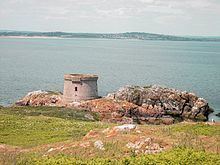Population 0 (2011) | County Dublin Area 22 ha Island group British Isles | |
 | ||
Flying around ireland s eye
Ireland's Eye (Irish: Inis Mac Neasáin) is a small uninhabited island off the coast of County Dublin, Ireland, situated directly north of Howth Harbour. The island is easily reached by regular tourist boats. The island is currently part of the county of Fingal, for administrative purposes, but was at one time part of the city of Dublin.
Contents
- Flying around ireland s eye
- Map of Irelands Eye Co Dublin Ireland
- Ireland s eye by boat close to the island june 2013
- History
- Structure and fauna
- Today
- Other projects
- References
Map of Ireland's Eye, Co. Dublin, Ireland
Ireland s eye by boat close to the island june 2013
History
In 1803 the Martello Tower was one of three built in Howth on the instructions of the Duke of York to repel a possible invasion by Napoleon. There is also the ruins of a church dating back to 700AD. The ruins of a Martello tower and an 8th-century church (the Church of the Three Sons of Nessan) are the only signs of previous habitation. The tower's window entrance 5 metres above ground level can now be accessed by a rope that hangs down from the window. The church functioned as parish church for Howth until recent centuries, eventually being replaced by a church in the village due to the limitations of having to take a boat for every service.
In Celtic times the island was called Eria's Island. Eria was a woman's name and this became confused with Erin, derived from Éireann, the Irish name for Ireland. The Vikings substituted the word Island with Ey, their Norse equivalent, and so it became known as Erin's Ey and ultimately Ireland's Eye. The island was also known formerly as Inis Faithlenn.
In September 1852 a woman named Sarah Maria Louisa Kirwan was killed on the island; her husband, William Burke Kirwan, was convicted of her murder. Matthias McDonnell Bodkin claimed in Famous Irish Trials that no murder had taken place, instead that Sarah Kirwan had drowned accidentally as a result of a fit.
Structure and fauna
Ireland's Eye comprises the main island, a range of rocks and an islet called Thulla. The most spectacular feature is the huge freestanding rock called "the Stack", at the northeastern corner of the island, which plays host to a large variety of seabirds, including thousands of guillemots, razorbills, fulmars and gulls. Ireland's fifth gannet colony became established on the Stack in the 1980s, and there are now a few hundred pairs breeding there each year. There is a large cormorant colony on the main island, and a few breeding pairs of puffins. Grey seals are abundant in the sea around the island.
Today
The Eye is a townland in its own right, with a registered area of 21.5 hectares (53 acres).
Ireland's Eye is served by two small boat companies from Howth Harbour in the summer months. Access to the island has never been restricted and admission is free, though transportation to the island may not be.
The island has long been established as a minor rock-climbing location. About 28 routes have been recorded since the 1940s, though it is believed that climbers have operated on the island since the 1910s or before. Climbing does not take place during the seabird nesting season of April to July.
In June 2015 a large portion of Ireland's Eye was scorched by gorse fires
Other projects
Media related to Ireland's Eye at Wikimedia Commons
